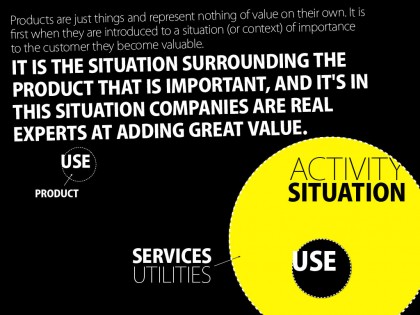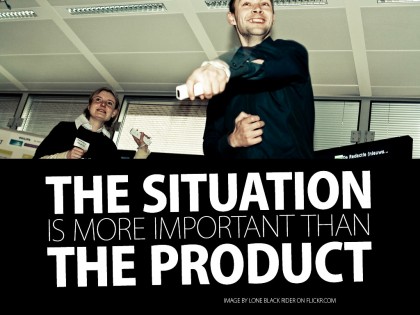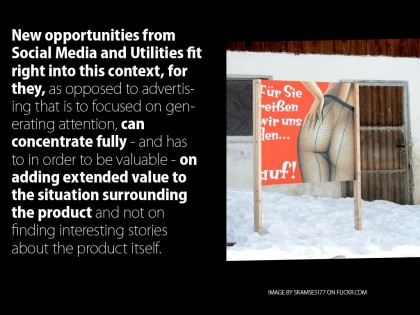Products are just stuff, and represent nothing of value on their own
erectile buy viagra online treatments that have been thoroughly tested in.
. It is first when they are introduced to a situation (or context) of importance to the customer they become valuable
. It is the situation surrounding the product that is important, and it’s in this situation companies are real experts at adding great value.

Nobody uses a product just to use it, they do it as a part of a larger activity, in order to complete a task or increase the value of a situation. As an example: A cup is worthless just sitting there on the shelf, but when you want to snuggle down with a hot cup of coffee it is essential. And it’s features, design and values, become very important to the whole experience.
This should underline the importance of understanding and working with situations, I would say, to some extent, that the situation is more important than the product – it is after all an insight into a situation that led to the design of the product in the first place – filling a need or a void – and the one that will lead to additional value from new services surrounding the product.

New opportunities from Social Media and Utilities fit right into this context, for they, as opposed to advertising that is to focused on generating attention, can concentrate fully – and has to in order to be valuable – on adding extended value to the situation surrounding the product and not on finding interesting stories about the product itself.
Social Media and Utilities introduce a much healthier and useful form of marketing, focusing on understanding how and why products and companies are valuable – and then further establishing and building on their situational value, rather than trying to squeeze some artificial attention out of a dead horse.



I like this line of thought Helge. I think you’re talking about the basic role of marketing here. I’d add to this the thought that advertising can explain context, while digital services and design can create context. Advertising helps you think differently about a product, digital services and design can change how you use it.
Great post.
Hi Adrian
Thank you for your attribution, always appreciate your valuable input, this is no exception. (I’ve been looking for an idea spark like this for weeks :o)
If I understand you correctly you are saying that as we are talking about situations (contexts), it’s not only important to understand the existing situation where the product already is creating value (and extend on this value), but also to look for new and other situations, which can be combined with our situation to create new unseen but gamechanging opportunities – what Mike Walsh calls “temporary states of monopoly”.
Like Fiat Eco:Drive, finding a brilliant way to combine the driving context with the eco-friendly context.
Again, brilliant spark :o) Thank you!
best
Helge
Well said, and very true. Products without their context are boring and lead to “featurespeak”. In fac, it is usually the context that lends itself best to being sold.
I think it was Mr. Ogilvy himself who,back in the 1950’s, coined the phrase “Don’t sell the steak, sell the sizzle”…
True that! Jeroen. In comms. it’s the sizzle :o)
My point is to look outside attention and interest – how can digital ad more value to a product already sizzling? And how can digital extend the value of a product experience outside of what it is already creating.
I find that with technology’s immersion into every day life a whole new set of opportunities emerge for marketers. What I try to do is to understand how all this affects the mindset we should have when work for clients, and at the same time try to understand how this effects the media industry – and discover the next generation “advertising”.
I do agree with the line of thought that products are worthless without appropriate context of use. As a product designer I always tried to solve the functional problem first i.e. products should help user to do certain task and provide values to the desired interactions people want to have with the product in the given context.
Considering situation is always the key in designing. Although sometimes products do create the situation and not you first create a situation and use any product to create the same experience then products are not worthless?
[…] Two things: – Products are worthless until they are introduced to the situation where they create value. (link) […]